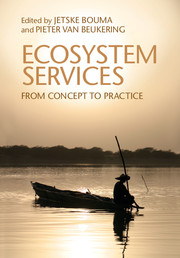Book contents
- Frontmatter
- Contents
- About the authors
- Part I Introduction
- Part II Measuring ecosystem services
- Part III Valuing ecosystem services
- 5 Economic values of ecosystem services
- 6 Economic valuation methods for ecosystem services
- 7 Trade-offs and decision-support tools for managing ecosystem services
- Part IV Paying for ecosystem services
- Part V Governing ecosystem services
- Index
- Plate section
- References
5 - Economic values of ecosystem services
from Part III - Valuing ecosystem services
Published online by Cambridge University Press: 05 February 2015
- Frontmatter
- Contents
- About the authors
- Part I Introduction
- Part II Measuring ecosystem services
- Part III Valuing ecosystem services
- 5 Economic values of ecosystem services
- 6 Economic valuation methods for ecosystem services
- 7 Trade-offs and decision-support tools for managing ecosystem services
- Part IV Paying for ecosystem services
- Part V Governing ecosystem services
- Index
- Plate section
- References
Summary
Introduction
Ecosystems provide important commodities and environmental benefits to society. As such, the management of ecosystems is an economic, social, and political issue encompassing all sectors of an economy. It involves trade-offs between competing uses and users, as well as between additional economic growth, ecosystem protection, and further natural resource depletion and degradation. Any particular use of ecosystems has its opportunity costs, consisting of the foregone benefits from possible alternative uses of the resource, including non-use. Decision-makers are faced with balancing these varied resource uses, for example, between freshwater demands from agricultural irrigation on the one hand, and the desire to protect rivers for fish and wildlife habitat on the other hand. Striking a balance between the trade-offs of economic growth and ecosystem resource use, possibly leading to their degradation and depletion, is crucial for the sustainable management of our natural resources. Economic valuation contributes to an improved natural resource allocation by informing decision-makers on the full social costs of ecosystem exploitation and the full social benefits of the goods and services that healthy ecosystems provide. This chapter addresses the various dimensions of economic and social value, before explaining the different valuation and evaluation techniques in Chapters 6 and 7, respectively.
- Type
- Chapter
- Information
- Ecosystem ServicesFrom Concept to Practice, pp. 89 - 107Publisher: Cambridge University PressPrint publication year: 2015
References
- 6
- Cited by

